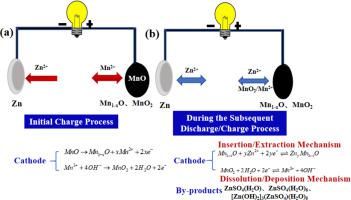当前位置:
X-MOL 学术
›
J. Electroanal. Chem.
›
论文详情
Our official English website, www.x-mol.net, welcomes your feedback! (Note: you will need to create a separate account there.)
The MnO@N-doped carbon composite derived from electrospinning as cathode material for aqueous zinc ion battery
Journal of Electroanalytical Chemistry ( IF 4.5 ) Pub Date : 2020-09-01 , DOI: 10.1016/j.jelechem.2020.114368 Fang Tang , Ting He , Huanhuan Zhang , Xianwen Wu , Yukang Li , Fengni Long , Yanhong Xiang , Ling Zhu , Jianhua Wu , Xianming Wu
Journal of Electroanalytical Chemistry ( IF 4.5 ) Pub Date : 2020-09-01 , DOI: 10.1016/j.jelechem.2020.114368 Fang Tang , Ting He , Huanhuan Zhang , Xianwen Wu , Yukang Li , Fengni Long , Yanhong Xiang , Ling Zhu , Jianhua Wu , Xianming Wu

|
Abstract Manganese-based oxides are considered as one of the most attractive cathode materials in aqueous zinc ion battery. However, the poor cycleability, inferior rate capability and associated with the ambiguous energy storage mechanisms seem to hinder its practical application. Herein, nitrogen-doped carbon-coated MnO (MnO@N-C) composite fibers were fabricated directly through an in situ strategy of electrospinning method, followed by two-step annealing processes. The results show that the cycling performances and rate capability of the as-prepared composite of MnO@N-C at 500 °C with graphite foil as the current collector (MnO@N-C-500-GF) are much better than that with stainless steel mesh (MnO@N-C-500-SSM). It delivers the reversible capacity of 176.3 mAh g−1 even after 200th cycles at 500 mA g−1 and 100.5 mAh g−1 at large current density of 1.2 A g−1 for the former. The electrochemical kinetics reveals that all the electrode reaction are mainly contributed by a diffusion-controlled process and partially dictated by the surface-controlled capacitive behavior. Significant insight into the energy storage mechanism is confirmed by ex situ X-ray diffraction. The detailed phase evolution process during the charge and discharge process indicates that MnO@N-C cathode with high reversibility and cycling stability experiences an insertion/extraction process of Zn2+ along with a dissolution/deposition mechanism due to Mn2+ dissolution.
中文翻译:

静电纺丝法制备的MnO@N掺杂碳复合材料作为水性锌离子电池正极材料
摘要 锰基氧化物被认为是水性锌离子电池中最具吸引力的正极材料之一。然而,循环性差、倍率能力差以及与不明确的储能机制相关的问题似乎阻碍了其实际应用。在此,氮掺杂碳包覆的 MnO(MnO@NC)复合纤维是通过原位静电纺丝方法直接制造的,然后是两步退火工艺。结果表明,以石墨箔为集流体(MnO@NC-500-GF)所制备的MnO@NC复合材料在500℃下的循环性能和倍率性能远优于不锈钢网( MnO@NC-500-SSM)。即使在 500 mA g-1 和 100 的第 200 次循环后,它也能提供 176.3 mAh g-1 的可逆容量。前者在 1.2 A g-1 的大电流密度下为 5 mAh g-1。电化学动力学表明所有电极反应主要由扩散控制过程贡献,部分由表面控制电容行为决定。非原位 X 射线衍射证实了对能量存储机制的重要洞察。充放电过程中详细的相演化过程表明,具有高可逆性和循环稳定性的 MnO@NC 正极经历了 Zn2+ 的插入/脱嵌过程以及由于 Mn2+ 溶解而产生的溶解/沉积机制。非原位 X 射线衍射证实了对能量存储机制的重要洞察。充放电过程中详细的相演化过程表明,具有高可逆性和循环稳定性的 MnO@NC 正极经历了 Zn2+ 的插入/脱嵌过程以及由于 Mn2+ 溶解而产生的溶解/沉积机制。非原位 X 射线衍射证实了对能量存储机制的重要洞察。充放电过程中详细的相演化过程表明,具有高可逆性和循环稳定性的 MnO@NC 正极经历了 Zn2+ 的插入/脱嵌过程以及由于 Mn2+ 溶解而产生的溶解/沉积机制。
更新日期:2020-09-01
中文翻译:

静电纺丝法制备的MnO@N掺杂碳复合材料作为水性锌离子电池正极材料
摘要 锰基氧化物被认为是水性锌离子电池中最具吸引力的正极材料之一。然而,循环性差、倍率能力差以及与不明确的储能机制相关的问题似乎阻碍了其实际应用。在此,氮掺杂碳包覆的 MnO(MnO@NC)复合纤维是通过原位静电纺丝方法直接制造的,然后是两步退火工艺。结果表明,以石墨箔为集流体(MnO@NC-500-GF)所制备的MnO@NC复合材料在500℃下的循环性能和倍率性能远优于不锈钢网( MnO@NC-500-SSM)。即使在 500 mA g-1 和 100 的第 200 次循环后,它也能提供 176.3 mAh g-1 的可逆容量。前者在 1.2 A g-1 的大电流密度下为 5 mAh g-1。电化学动力学表明所有电极反应主要由扩散控制过程贡献,部分由表面控制电容行为决定。非原位 X 射线衍射证实了对能量存储机制的重要洞察。充放电过程中详细的相演化过程表明,具有高可逆性和循环稳定性的 MnO@NC 正极经历了 Zn2+ 的插入/脱嵌过程以及由于 Mn2+ 溶解而产生的溶解/沉积机制。非原位 X 射线衍射证实了对能量存储机制的重要洞察。充放电过程中详细的相演化过程表明,具有高可逆性和循环稳定性的 MnO@NC 正极经历了 Zn2+ 的插入/脱嵌过程以及由于 Mn2+ 溶解而产生的溶解/沉积机制。非原位 X 射线衍射证实了对能量存储机制的重要洞察。充放电过程中详细的相演化过程表明,具有高可逆性和循环稳定性的 MnO@NC 正极经历了 Zn2+ 的插入/脱嵌过程以及由于 Mn2+ 溶解而产生的溶解/沉积机制。



























 京公网安备 11010802027423号
京公网安备 11010802027423号